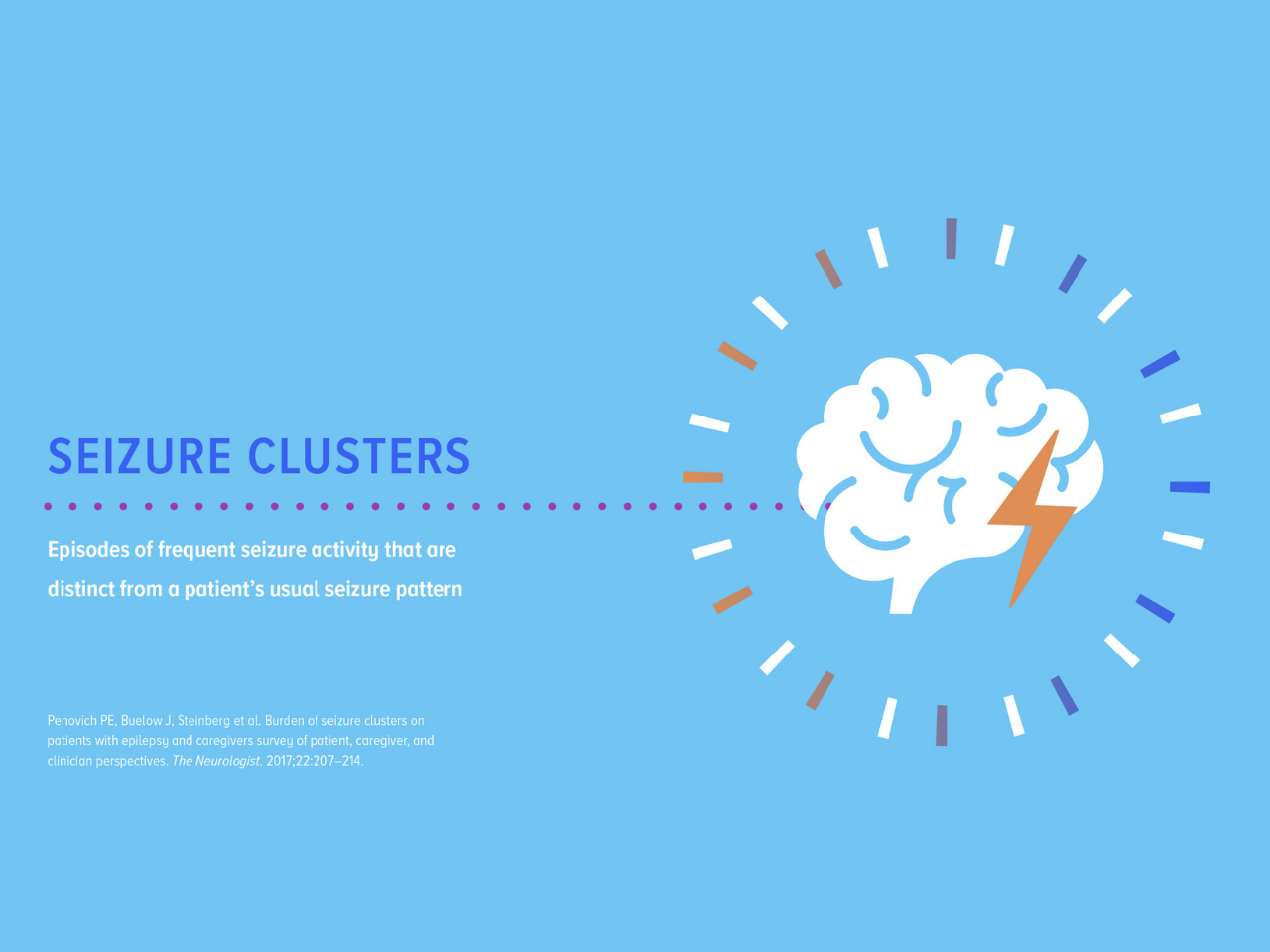
At UCB, we keep patients at the center - inspiring us, driving our scientific discovery, and leading us to rethink the patient experience. We have a rich heritage in epilepsy, and today, we’re shining a spotlight on seizure clusters, which can affect people with uncontrolled epilepsy, to help spread awareness.
What are seizure clusters? Seizure clusters are episodes of frequent seizure activity that are distinct from a patient’s usual seizure pattern.1 They are a type of seizure emergency, where patients experience multiple seizures with a recovery in between over a number of hours or days.1 Three out of four patients live in fear of having the next seizure cluster.1
How common are seizure clusters? It is estimated that more than 150,000 people in the U.S. with uncontrolled epilepsy also experience seizure clusters.2, 3, 4
How do seizure clusters impact patients? A seizure may only last 1 to 2 minutes, but a seizure cluster can typically last for hours, and an untreated seizure cluster can have potentially serious consequences, including physical injury, hospitalization, neurological damage, status epilepticus, and mortality.1, 5-13
For both patients and their caregivers, seizure clusters may limit the ability to work or study, interfere with daily activities, family and social life, and negatively affect mood.1 Seizure clusters have been linked with a high rate (73%) of emergency seizure-related hospitalization.8 And a seizure-related emergency may include emergency room visits, making it expensive for the patient or caregiver and our healthcare system.14
With over 20 years of experience in the research and development of solutions for patients with epilepsy, we are dedicated to continuing to our mission to address unmet needs. We are proud to contribute to advances in the understanding of epilepsy and are dedicated to serving patients living with seizure clusters, so they can live their best lives.
Check out this infographic to learn more.
References
- Penovich PE, Buelow J, Steinberg et al. Burden of seizure clusters on patients with epilepsy and caregivers survey of patient, caregiver, and clinician perspectives. The Neurologist. 2017;22:207–214.
- Zack M, R Kobau. National and State Estimates of the Numbers of Adults and Children with Active Epilepsy. CDC MMWR. 2017. 66:821-825.
- Kwan P, M Brodie. Early Identification of Refractory Epilepsy. NEJM. 2005. 342:314-319.
- Chen B, Choi H, Hirsch L, et al. Prevalence and risk factors of seizure clusters in adult patients with epilepsy. Epilepsy Res. 2017;133:98-102.
- Jafarpour S, Hirsch LJ, et al. Seizure cluster: Definition, prevalence, consequences, and management. Seizure. 68:9-15.2019.
- McKee H, A. Bassel. Outpatient Pharmacotherapy and Modes of Administration for Acute Repetitive and Prolonged Seizures. CNS Drugs. 2015. 29:55-70.
- Ferastraoaru V. Termination of seizure clusters is related to the duration of focal seizures. Epilepsia. 57(6):889–895, 2016.
- Haut SR, Shinnar S, Moshé SL. Seizure clustering: risks and outcomes. Epilepsia. 2005;46(1):146-149.
- Sillanpää M, Schmidt D. Seizure clustering during drug treatment affects seizure outcome and mortality of childhood-onset epilepsy. Brain. 2008;131(Pt 4):938-944.
- Haut S. Seizure clusters: characteristics and treatment. Current Opinion Neurology. 28:143–150, 2015.
- Status Epilepticus. Epilepsy Foundation. Accessed October 1, 2019. https://www.epilepsy.com/learn/challenges-epilepsy/seizure-emergencies/status-epilepticus.
- Buck D, et al. Patients' Experiences of Injury as a Result of Epilepsy. Epilepsia. 38(4):439-444, 1997.
- Cereghino JJ, Mitchell WG, et al. Treating repetitive seizures with a rectal diazepam formulation: a randomized study. The North American Diastat Study Group. Neurology. 1998;51(5):1274-1282.
- Data on file. UCB, Inc. IBM MarketScan Commercial Claims research database (CCMC 2008-2018 v0.1).
US-P-DA-EPI-1900067
Choose Country
- Global Site – English
- Australia – English
- België – Engels
- Belgique – Anglais
- Brasil – Português
- България – Български
- Canada – English
- Canada – Français
- 中国 – 中文
- Česká Republika – Angličtina
- Danmark – Engelsk
- Deutschland – Deutsch
- France – Français
- España – Español
- Ελλάδα – Ελληνικά
- India – English
- Ireland – English
- Italia – Inglese
- 日本 – 日本語
- Казахстан – ағылшын тілі
- 한국 – 한국어
- Luxembourg – Anglais
- Luxemburg – Engels
- Magyarország – Angol
- México & Latinoamérica – Español
- Nederland – Engels
- New Zeeland – English
- Norge – Engelsk
- Österreich – Deutsch
- Polska – Polski
- Portugal – Inglês
- România – Engleză
- Россия – Русский
- Slovensko – Anglický
- Suomi – Englanti
- Sverige – Engelska
- Schweiz – Deutsch
- Suisse – Français
- Türkiye – Türkçe
- Україна – Англійська
- United Kingdom – English
- U.S.A. – English



